Anchovy broth is the base stock for many Korean recipes from soups and stews and so it’s a must recipe in Korean Cooking. In this post, I share how to make 3 different variations of this wonderful broth including tips for making ahead.
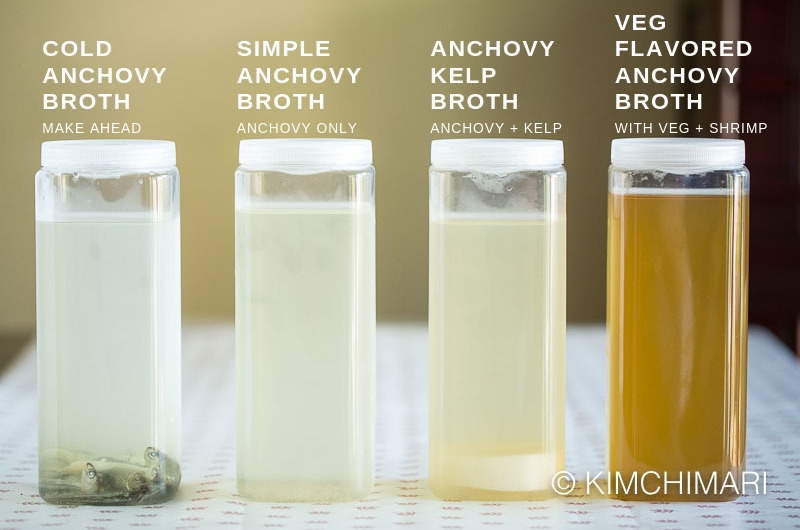
Anchovy broth (stock) or Myeolchi Yuksu (멸치육수) is a very simple fish broth that adds a very clean and mild umami flavor to many Korean soup or stews. It may almost taste like nothing when you taste it by itself but it adds such a great depth of flavor to your dishes. Knowing how to make this broth was such a life changer for me as a newlywed cook because often times I didn’t have time to make the richer beef broth for soups and stews – which usually takes hours.
As you can see simply from the colors, the differences in flavor between the 4 broths is that broth flavor gets more complex and strong as the color goes dark (from left to right). The number of ingredients added also increases with darker colors. Now you may wonder, why not just make and use the stronger tasting broth for everything??
Well.. you can but I’m sure you heard of the term ‘less is more ‘… and I’m a firm believer that the same concept applies to cooking too. And because broth #4 has shrimps and shitake, they may add some unwanted flavor for some dishes. But you are welcome to try it and see how you like it.
So, be sure to read below, which broth I recommend for which dishes. But first, a little bit about the ingredient.
About Korean Dried Anchovies for Broth/Stock (Gukmulyong Maleun Myeolchi 국물용 마른 멸치)
MEANING – Gukmul 국물 literally means soup water and Yong 용 means ‘for use in‘. Maleun 마른 means dried.
SCIENTIFIC NAME – Also called Japanese Anchovy, Engraulis Japonicus is a schooling fish of the family Engraulidae. It’s commonly found in the Pacific Ocean near Korea, Japan, Philipines and Indonesia. It is said to grow as large as 12-13 cm.
How Anchovies are Dried – Did you know that freshly caught anchovies are boiled in huge cauldrons and then dried in sun? This link is from a Korean site but you can see the pictures of boiling and drying anchovies at the bottom of this post.
SIZES – Korean anchovies (Myeolchi 멸치) comes in all different sizes from tiny ones (1-2 cm) to big ones – as big or even bigger than 10-11 cm!! And for making broth, anchovies bigger than 6 cm are usually used. I tend to use the ones that are a bit smaller than the largest soup anchovies because personally, I don’t think the extra-large ones make as yummy a stock as do these.
I had 2 different sizes in my fridge that I use for soup stock and here’s a picture of the dried anchovies for broth.
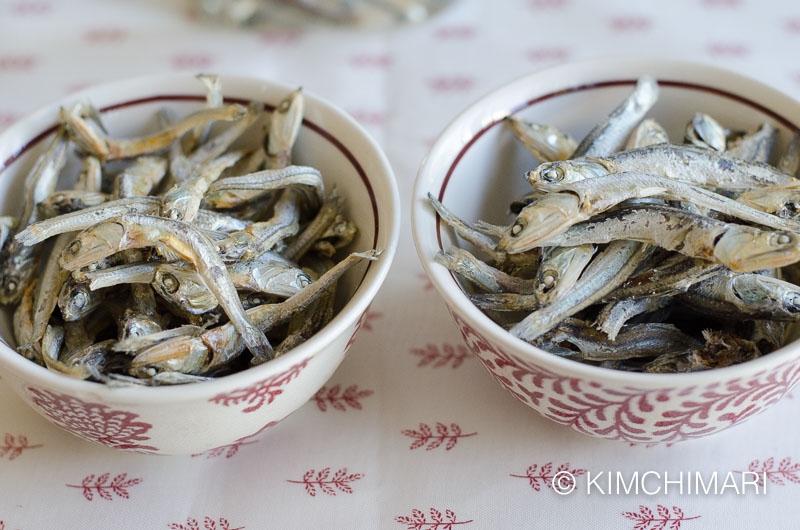
The left ones are about 6 cm (2.3 in) long and the right ones are about 7-8cm (3 in) long. I like to use the bigger ones on the right but the smaller ones on the left work fine too. You just need to use more if using the smaller ones.
TIPS for Perfect Anchovy Broth
BUYING TIPS – If you can, buy ones that are from Korea if possible – they just produce a tastier stock. Buy ones that are less dry (not totally rock hard) which means they are fresher. BEST way is to actually taste the fish and see how it tastes. You will find that one actually taste better than the other. Remember, don’t eat the big anchovy whole including the guts 😝😣- take out the guts before eating them because the gut part can taste pretty unpleasant.
Why do you gut the anchovies before making stock?
The reason for gutting the anchovies is because it can leave an unpleasant bitter taste to the stock if there are lots of it. BUT – you actually don’t have to gut them if they are around the size that I use (above).
Do you ALWAYS NEED to gut them?
NO. Most recipes will tell you to always gut the anchovies before making broth and take the head off. Taking the gut out is necessary only if the fish is really big (around 3 inch or bigger) otherwise, it’s totally fine to use the whole thing. I used to gut them before too because that’s what I’ve always been told but I found that it’s actually fine to use the whole thing when they are about the sizes in the picture above.
How do you gut the Korean dried anchovies for anchovy broth?
Using both hands, hold the anchovies so the back is facing up. Split the anchovies in the middle (from the back) then it will split open in half, exposing the backbones and the gut. Take out the gut. As you do, the head will naturally fall off. Don’t discard the heads, SAVE the heads. My mom used to save all the heads and use it to make stock later. Use about the same volume of heads as when using whole anchovies.
How to choose/buy good quality Myeolchi
- Buy ones that are caught in Korea. I find the ones from Korea have more flavor due to the particular type of anchovies and also how they are dried.
- Buy anchovies that are meaty looking and that actually taste good
- Buy ones that are less dry (if you can). The drier they are, chances are they are not as fresh.
Step-by-Step Directions
- COLD ANCHOVY BROTH- NO COOKING
- instead of cooking the anchovies in pot, just soak a handful of anchovies in water for 3-4 hrs at normal room temperature (not too hot) OR leave it overnight up to 3-4 days in the fridge. I found that it had more flavor day #2 or prepare way ahead for best flavor. Also, this way you always have anchovy broth ready to go in your fridge.
- cleanest and clear tasting broth – great base for any recipe.
- KEEP in fridge for at least 3-4 days.
Dried Anchovies for Cold Anchovy Broth
- SIMPLE ANCHOVY BROTH RECIPE
- in a pot, add water, add about a handful of soup anchovies. Bring to a simmer, UNCOVERED and cook for 20 to 25 minutes. Alternatively, you can soak the anchovies in cold water for 30 minutes to several hours (or even overnight) beforehand and then simmer for 10 minutes. Remove anchovies and discard (or give to your dog 🐶or cat 🐱! THEY LOVE these!!)
- clean and clear tasting broth – great for simple soups
- Keep in fridge for at least 3-4 days.
Anchovy broth in pot
- ANCHOVY BROTH with KELP and RADISH
- DON’T RINSE KELP – when preparing KELP, don’t rinse away the white stuff – this has great umami. Just wipe off any sand or dust with a lightly damp cloth.
- in a pot with water, add dried anchovies, radish and kelp and bring to simmer, UNCOVERED, cook for 10 minutes. Then remove dasima (kelp or kombu) and simmer for another 10 – 15 minutes. Remove anchovies and optionally radish if your recipe doesn’t need it. Otherwise, you can eat the radish.
- Keep in fridge for 2-3 days.
Anchovy Kelp Broth
- ANCHOVY BROTH with Vegetables
- prepare the ingredients by either rinsing the shitake and green onions. If you have an organic onion, use the peels too as it adds more flavor otherwise peel. Also adding the green onion roots add good flavor and nutrition so leave it in.
- in a pot with water, add dried anchovies, dasima, onion, green onion or leek, radish and dried shitake mushrooms. You can also add dried red shrimps (the kind you make banchan with) but you may also want to omit it if you don’t want too much of a fishy flavor.
Dried shrimp for stock - Bring to simmer and cook for 25-30 min. Take out the kelp sooner than 25 min, maybe at 10-15 min – kelp starts to produce sticky stuff if you leave it in too long. Once done, strain the broth.
- Keep in fridge for 2-3 days.
Anchovy Broth with Vegetables Ingredients This is after it has simmered and is ready to be strained.
Anchovy Broth with Veggies BTW, instead of straining you can use a cheesecloth bag or a cotton soup bag (here in my Amazon store) OR I had this giant soup bag that I bought in Korea. For this, you just need to lift the bag out after you’re done. No straining needed.
Anchovy stock simmering in soup bag
AND THERE YOU GO!!
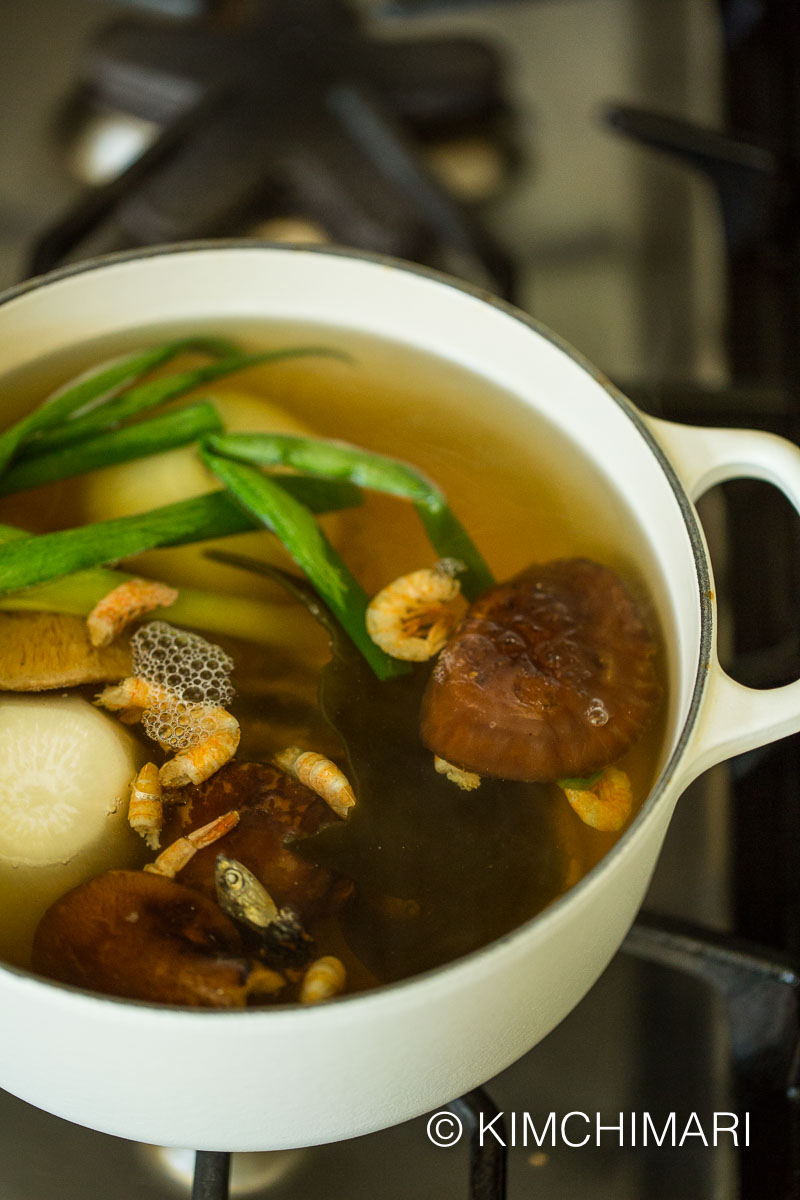
RECIPES THAT USE SIMPLE ANCHOVY BROTH #1 & #2
- Rice Cake Soup (Tteokguk)
- Soybean Paste Radish Soup (Doenjang Mu Guk)
- Soybean Sprout Soup (Kongnamul Guk)
- Dried Pollock Soup (Bugeo Guk).
- Spicy Zucchini Gochujang Stew (Gochujang Hobak Jjigae)
- Although I didn’t include it in my recipes, you can totally add this broth to Kimchi Jjigae or Soft Tofu Stew and it will make it taste even better.
RECIPES THAT USE #3 ANCHOVY BROTH with KELP and RADISH
- Bulgogi Hot Pot (Jeongol)
- Soybean Paste Stew (Doenjang Jjigae)
- Spicy Pollock Roe Stew (Altang 알탕)
- Fish Cake Soup (Odeng Guk)
- Tteokbokki with Vegetables
RECIPES that use #4 ANCHOVY BROTH with Vegetables and Aromatics
This broth is indeed the ULTIMATE anchovy broth with everything in it but be careful about using it because it can get in the way. So use it instead of 1-3 for more enhanced flavor and also for more heavily seasoned dishes like stews or soups. Depending on the flavor profile, you may want to either omit shrimp or shitake.
- Easy Mille Feuille Nabe (Shabu Shabu) – omit the shrimp
- Use this instead of #1 broth to make Tteokguk, Doenjang Jjigae
- Although I don’t have a recipe for this yet, you can use this broth to make Korean Noodle Soup (Jangteo Guksu).
Hope this was helpful.
If you have tried this or any other recipe on my blog then please rate the recipe (☆☆☆☆☆ at the top right of the recipe card) and leave me a comment to let me know how you like it! Every 5 star helps me a lot and I also love hearing from you! 😍
You can also FOLLOW ME on FACEBOOK, PINTEREST and INSTAGRAM or join my FACEBOOK GROUP to ask and share everything about Korean food with others just like you!
Enjoy!
XOXO ❤️,
JinJoo
Anchovy Broth (From simple to full flavored)
Ingredients
Anchovy Broth #1 (Cold Method)
- 5 cups water
- 20 g dried anchovies for soup (Gukmulyong Myeolchi, about 16-18, 7-8cm each)
Anchovy Broth #2 (Anchovy only)
- 6 cups water
- 20 g dried anchovies for soup (Gukmulyong Myeolchi, about 16-18, 7-8cm each)
Anchovy Broth #3 (with Kelp and Radish)
- 6 cups water
- 20 g dried anchovies for soup (Gukmulyong Myeolchi, about 16-18, 7-8cm each)
- 4 oz Korean radish
- 1 piece Kelp (Dasima or Kombu) (3 x 2 inch piece)
Anchovy Broth #4 (with shrimp and vegetables)
- 7 cups water
- 1 each small onion
- 1 each green onion
- 4 each shitake mushrooms
- 4 oz Korean Radish (1 x 3 inch disc, peeled - Daikon is ok)
- 1 pc Dried Kelp (Dasima or Kombu) (3 x 2 inch piece)
- 13 pc dried red shrimp
Instructions
Anchovy Broth #1 (COLD METHOD)
- Soak a handful of anchovies in water for 3-4 hrs at normal room temperature (not too hot) OR leave it in the fridge overnight or up to 3-4 days. I found that it had more flavor day #2 or prepare way ahead for best flavor. Also, this way you always have anchovy broth ready to go in your fridge.
Anchovy Broth #2
- In a pot, add water, add about a handful of soup anchovies. Bring to a simmer, UNCOVERED and cook for 20 to 25 minutes. Alternatively, you can soak the anchovies in cold water for 30 minutes to several hours (or even overnight) beforehand and then simmer for 10 minutes. Remove anchovies and discard (or give to your dog 🐶or cat 🐱! THEY LOVE these!!)
Anchovy Broth #3 with Kelp and Radish
- How to Prep KELP - when preparing KELP, don't rinse in water and remove the white stuff - this has great umami. Just wipe off any sand or dust with a lightly damp cloth.
- In a pot with water, add dried anchovies, radish and kelp and bring to simmer, UNCOVERED, cook for 10 minutes. Then remove dasima (kelp or kombu) and simmer for another 10 - 15 minutes. Remove anchovies and optionally radish if your recipe doesn't need it. Otherwise, you can eat the radish too.
Anchovy Broth #4 with Vegetables
- Prepare ingredients by cleaning/rinsing the shitake and green onions. If you have an organic onion, leave the peel on as it adds more flavor. Otherwise, peel onion. Also adding the green onion roots add good flavor and nutrition, so leave it in.
- In a pot with water, add dried anchovies, dasima, onion, green onion or leek, radish and dried shitake mushrooms. You can also add dried red shrimps (the kind you make banchan with) but you may also want to omit it if you don't want too much of a fishy flavor
- Bring to simmer and cook for 25-30 min. Take out the kelp sooner than 25 min, maybe at 10-15 min - kelp starts to produce sticky stuff if you leave it in too long. Once done, strain the broth
- Instead of straining you can use a cheesecloth bag or a cotton soup bag (here in my Amazon store) OR I had this giant soup bag that I bought in Korea. For this, you just need to lift the bag out after you're done. No straining needed.
Tips & Notes:
- When you make the broth with the lid covered, there's a good chance your broth may come out fishy smelling so it's always best to keep it uncovered until it's cooled.
- If you are not going to cook with the anchovy broth right away, store all anchovy broth in the refrigerator as soon as it cools.
- The simpler anchovy broth (#1,2) will keep for 3-4 days and the other two broths should be good for at least 2-3 days.
- You can use the same recipe but increase the amount by 1.5 and make it in your Instant Pot. With the cover open, bring to a boil but selecting SAUTE function. As soon as it starts to boil, immediately stop the SAUTE and switch to WARM function. Keep it in warm function for the time needed in the recipe.

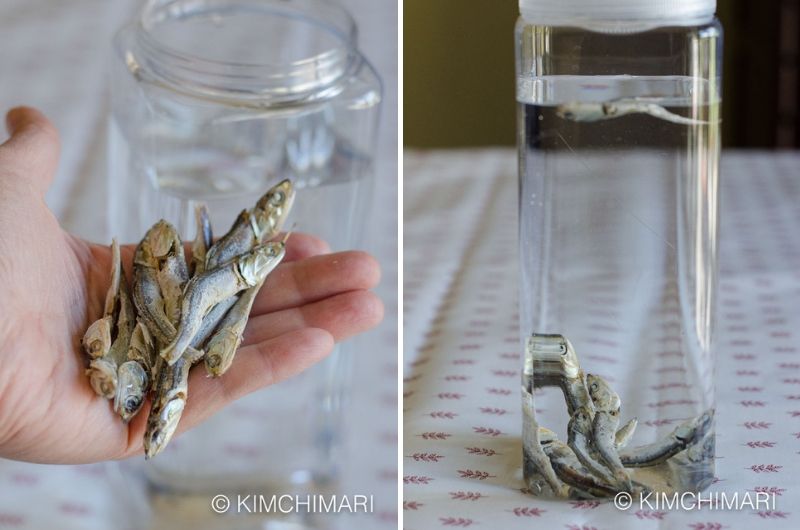
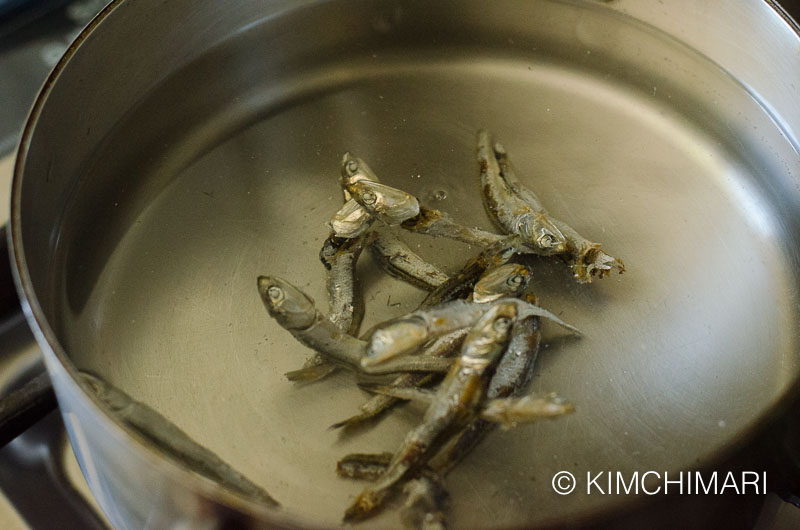
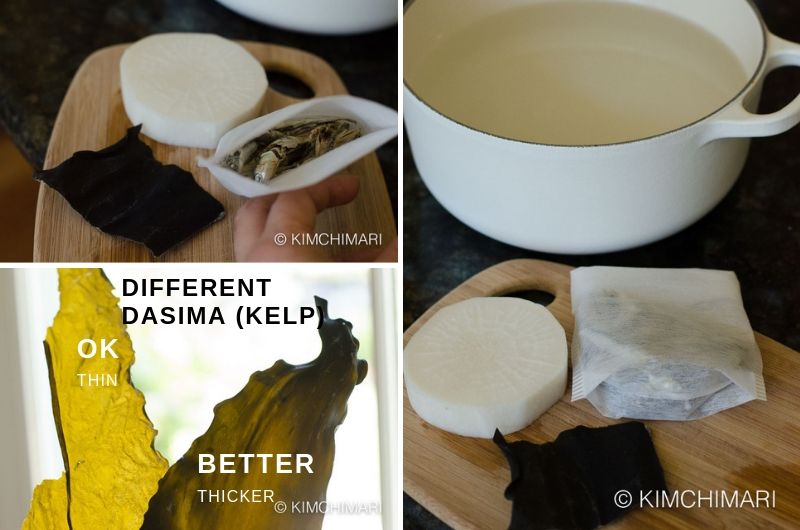
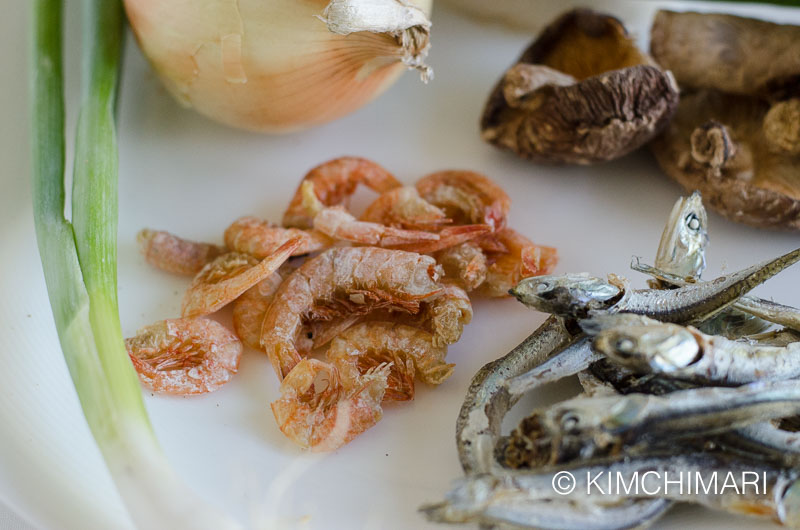

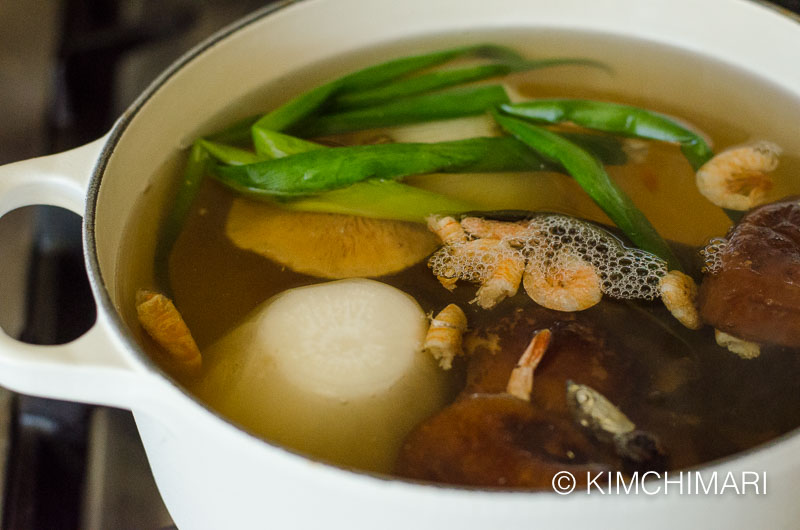
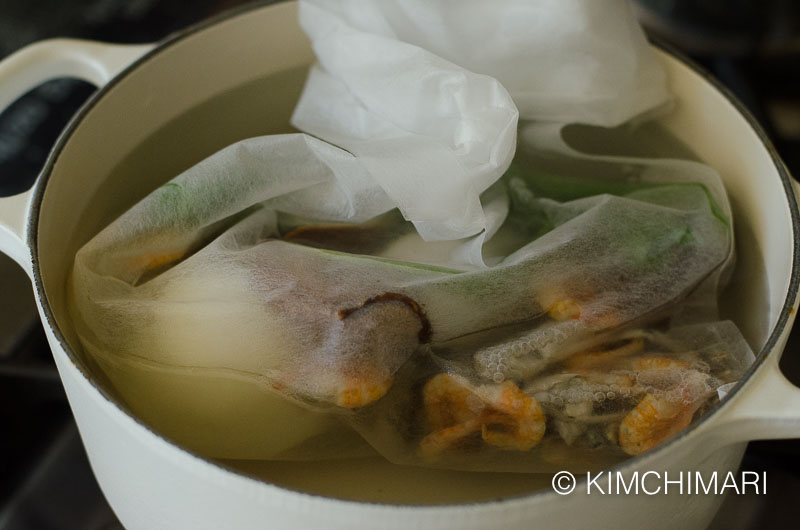
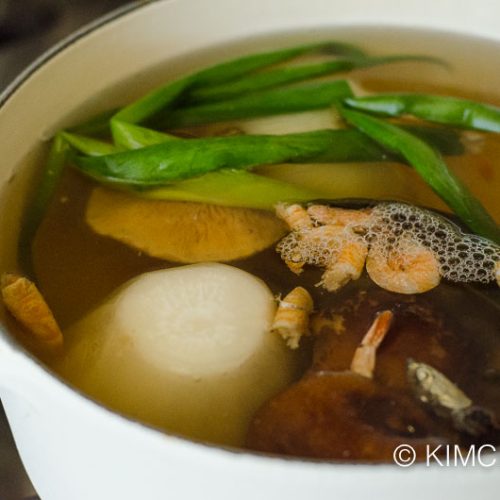
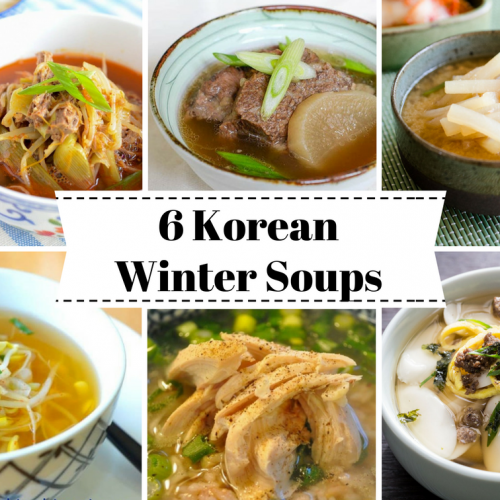
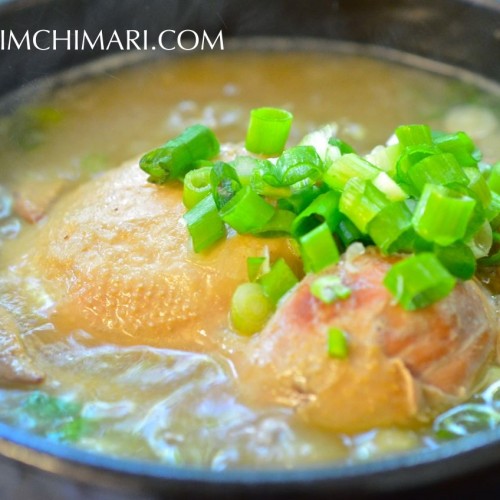
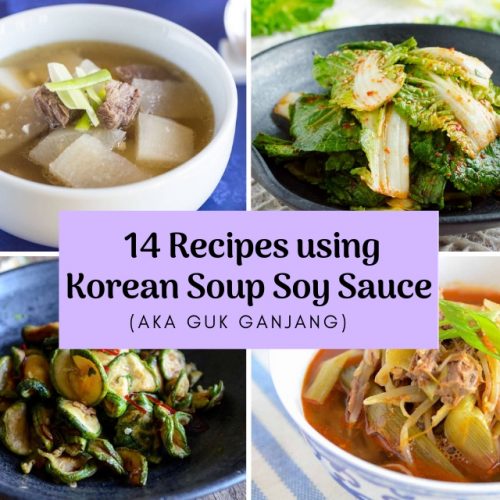
















First, i wanted to express my appreciation for your recipes! your site is one of the places i go when i’m looking to make a korean recipe. Soups and stews were a regular in meals when i was growing up, and i’ve grown to love them more as an adult!
quick question- do you have a reccs for vegetable based broth? in korean cooking i know that beef and anchovy broth are the mainstays, but i would love to be able to make a veggie based one. thinking dried mushrooms, onion, a piece of kombu? i feel like it would need something else then just these. Maybe a big chunk of mu?
Oh Esther, I’m sooo glad! I know.. Koreans just love soup and stews! For vegetable broth, yes you totally have the right idea! I would make it with some onion, radish, cabbage (either napa or green), green onions (daepa would be best), mushrooms (dried shitake) and dasima (kombu)! And you could throw in some carrots for extra sweetness.
where are those glass containers from? or what was the product you bought? i like how tall they are haha
Ooh those are actually plastic and you can buy them on amazon sometimes – look for the brand silicook (if I’m correct). Thanks!
You answered the question I had about the anchovies, which was “why should you gut them?” because recipes usually say to do so, but my mom doesn’t. Thanks!
And thanks for the easy-to-follow instructions, I’m going to up my soup game.
Just want I wanted to hear! So many recipes just follow whatever they are basing it on so..like many Korean recipes tell you to rinse the meat before cooking which I find it unnecessary in most cases. Awesome to hear that it will up your soup game! Thank you for your feedback.
I love the anchovy and kelp recipe. Teehee it stays in my fridge. Have to have it for my deonjang jjigae.